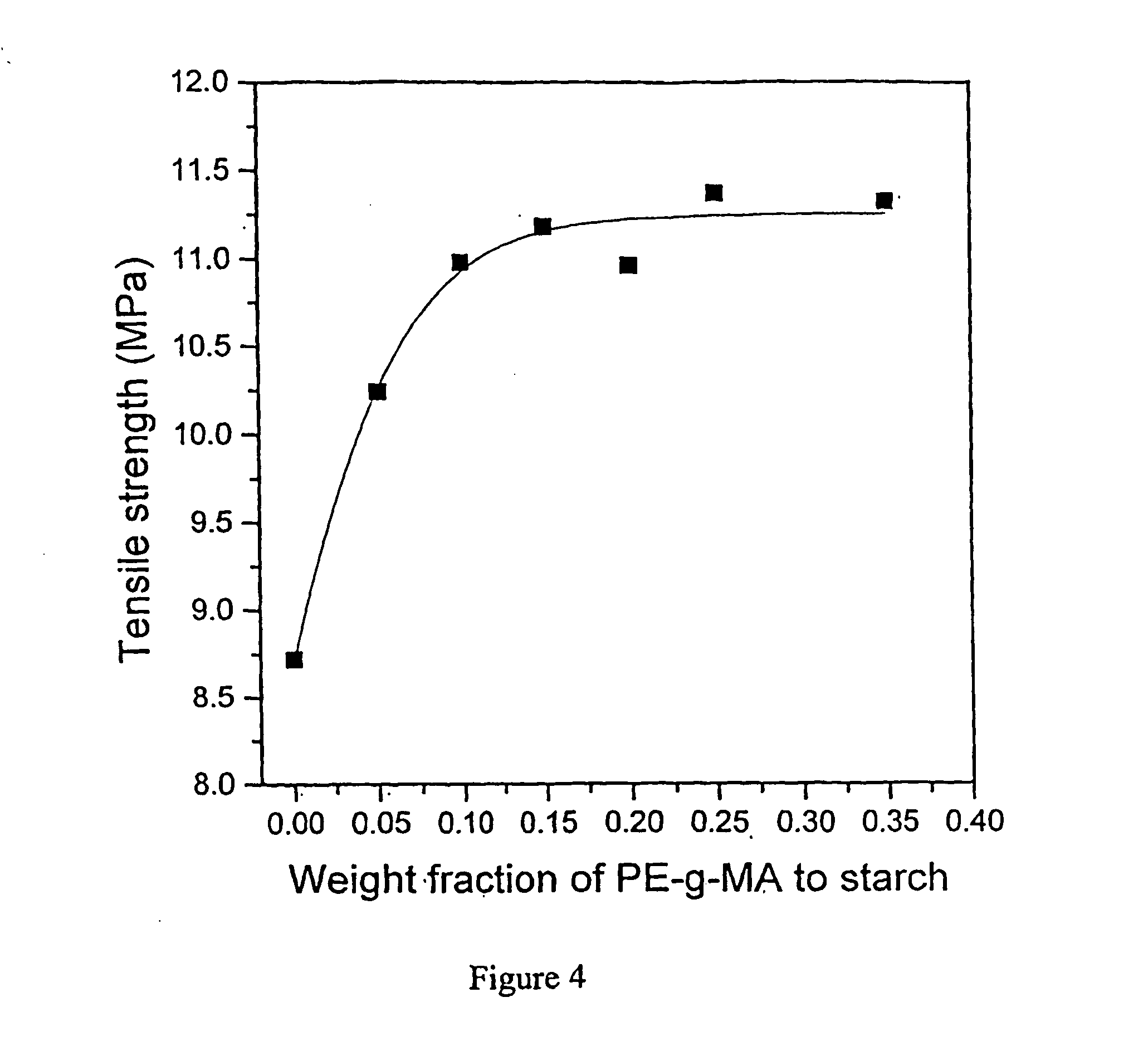Biodegradable materials from starch-grafted polymers
a technology of starch grafting and biodegradable materials, which is applied in the field of biodegradable materials from starch grafted polymers, can solve the problems of affecting the blending effect, so as to facilitate the blending of starch and the effect of less cost and less cos
- Summary
- Abstract
- Description
- Claims
- Application Information
AI Technical Summary
Benefits of technology
Problems solved by technology
Method used
Image
Examples
example 1
[0041] Low Density Polyethylene (LDPE) is a product of Dow Chemical Company (Midland, Mich.), LDPE 6401, with a melt flow index of 2 g / 10 min. Commercial cornstarch was obtained from Cerestar USA Inc. (Hammond, Ind.). Cornstarch was dried at 120° C. for 24 hr to a moisture content of less than 1% prior to samples preparation. Polyethylene grafted maleic anhydride (PE-g-MA) may be obtained from Aldrich Chemical Company In. (Milwaukee, Wis.).
[0042] Cornstarch, PE-g-MA (10% of Cornstarch weight) and LDPE were blended at room temperature with a KitchenAid mixer (St. Joseph, Mich.) at starch to LDPE ratios of 5%, 10%, 15%, 20%, 25% (w / w). Then these blends were melt-blended in a lab scale twin screw counter-rotating extruder (PolyLab, ThermoHaake, Madison, Wis.) with a processing temperature of 170° C. and a processing speed of 50 rpm.
[0043] Dumbbell-shaped specimens were prepared from extruded samples. The tensile tests were carried out with an Universal Testing Machine (Model 1011, I...
example 2
[0047] Low density polyethylene (LDPE, LDPE 6401, Dow Chemical Co., Midland, Mich.) with a melt flow index of 2 g / 10 min was used. Common corn starch was obtained from Cerestar USA, Inc. (Hammond, Ind.). Corn starch was dried at 120° C. for 24 hr. to a moisture content of less than 1% prior to sample preparation. PE-g-MA with an approximate maleic anydride content of 3 wt % was purchased from Aldrich Chemical Company Inc. (Milwaukee, Wis.).
[0048] Corn starch and LDPE (25 / 100) were pre-mixed at room temperature using a KitchenAid mixer (St. Joseph, Mich.) with different amounts of compatibilizer (PE-g-MA, 0, 5, 10, 15, 20, 25 and 35% w / w based on starch) in order to determine the critical saturated interfacial concentration of PE-g-MA for the corn starch and LDPE system. These mixtures were then melt-blended in a lab scale twin-screw counter-rotating extruder (PolyLab, ThermoHaake, Madison, Wis.) at 170° C. and 50 rpm.
[0049] Once the critical saturated interfacial concentration of ...
PUM
| Property | Measurement | Unit |
|---|---|---|
| Fraction | aaaaa | aaaaa |
| Fraction | aaaaa | aaaaa |
| Fraction | aaaaa | aaaaa |
Abstract
Description
Claims
Application Information
 Login to View More
Login to View More - R&D
- Intellectual Property
- Life Sciences
- Materials
- Tech Scout
- Unparalleled Data Quality
- Higher Quality Content
- 60% Fewer Hallucinations
Browse by: Latest US Patents, China's latest patents, Technical Efficacy Thesaurus, Application Domain, Technology Topic, Popular Technical Reports.
© 2025 PatSnap. All rights reserved.Legal|Privacy policy|Modern Slavery Act Transparency Statement|Sitemap|About US| Contact US: help@patsnap.com



